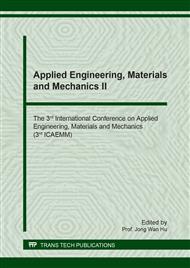p.278
p.287
p.292
p.299
p.305
p.311
p.316
p.323
p.328
Experimental Study on Post Fire Tensile Properties of Reinforcing Rebars Connected by Grout-Filled Splice Sleeves
Abstract:
This paper presents some experimental results of tensile properties of reinforcing bars spliced by grout-filled coupling sleeves after exposed to fires to identify the effect of temperature histories on tensile properties of spliced reinforcing bars, which provide a useful base for assessing structural behaviors of precast reinforced concrete buildings damaged by fires. A spliced rebar system investigated in this paper consists of two equal-diameter steel reinforcing bars with 25mm diameter and a straight coupling sleeve with 55mm outer and 42mm inner diameters. As a result, the thickness of grout between internal steel bars and outer sleeves are 8.5mm. Five test specimens are manufactured in identical technology and divided into three groups. First group is reference group consist of just one specimen which is not exposed to fire. Second and third groups consist of two specimens that are exposed to ISO 834 standard fire in furnace for 15 and 25 minutes respectively. The temperature-time curves of grout between rebars and sleeves are measured via thermocouples embedded in grout. Subsequently, a universal testing machine is used to test the ultimate load bearing capacities of five specimens. Test results demonstrate that ultimate load bearing capacities of steel rebars spliced by grout-filled sleeves are considerably reduced due to fire damaged grout.
Info:
Periodical:
Pages:
305-310
Citation:
Online since:
July 2018
Authors:
Price:
Сopyright:
© 2018 Trans Tech Publications Ltd. All Rights Reserved
Share:
Citation:


